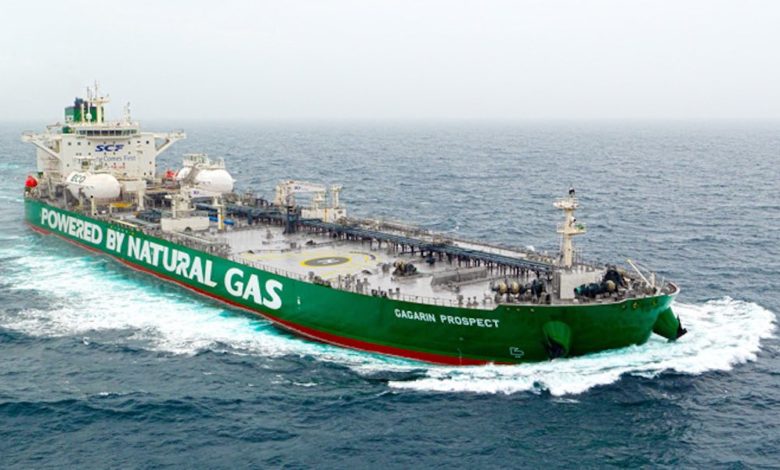Russia-China dirty tanker trade soars 94% after Ukraine invasion

New data from BIMCO gives a clear indication of one of the main shipping themes since the start of Russian invasion of Ukraine in late February – Asia is buying up cheap Russian commodities shunned by the West.
China is the world’s largest importer of crude oil and Russia is the second largest crude exporter. Much of the crude oil trade between the two countries, however, is piped and the short distance from Far East Russia to China also limits the impact on demand for crude oil tankers. Still, a change in the Russia to China dirty trade has the potential to impact tanker tonne miles demand as it could come at the expense of longer trade lanes.
“Since Russia’s invasion of Ukraine, the Russia to China dirty tanker trade has soared 94% year-on-year measured in deadweight tonne miles,” said Niels Rasmussen, chief shipping analyst at BIMCO. This compares to a year-to-date increase of only 9% year-on-year prior to the invasion.
In comparison, total dirty tanker deadweight tonne miles exports from Russia, and imports to China, have risen 14% year-on-year and 4% year-on-year respectively since the invasion highlighting how the Russia to China trade has increased in importance for both countries.
“Accounting for 58% of the increase, it is particularly the relatively long Black Sea to China trade that has driven the overall increase in the post-invasion Russia to China dirty tanker trade,” said Rasmussen.
As deadweight tonne miles in the even longer Brazil to China trade has decreased 26% year-on-year during the same period the BIMCO analyst said it appears that the shift in China’s import patterns has reduced average miles/tonne in the Chinese import trades which overall is a negative for the dirty tanker trade.
Plenty of other data focused on Russian energy exports shows how much is now shifting east to Asia.
A count of voyages originating from Russia for the global tanker and dry bulk fleets, as tracked by shipping platform Sea/, shows the number of laden voyages took a dip around the end of February when the invasion of Ukraine began but has been creeping up in recent weeks. Top destinations are Turkey, China, South Korea and Japan.

More important is the trade between India and Russia, as basically stated with “Much of the crude oil trade between the two countries, however, is piped and the short distance from Far East Russia to China also limits the impact on demand for crude oil tankers”. So India will have a far, far greater impact, and we know India has been purchasing large quantities of crude etc. from Russia.
Why did you delete the facts I posted?
Read this
“India’s Russian oil purchases since Ukraine invasion more than double 2021 total
in Freight News 27/04/2022
India has bought more than twice as much crude oil from Russia in the two months since its invasion of Ukraine as it did in the whole of 2021, according to Reuters calculations, as Indian refiners snapped up discounted oil that others have shunned.
Refiners in India have placed orders for at least 40 million barrels of Russian oil since the invasion on Feb. 24, Reuters calculations based on information from crude tenders and traders show. The purchases are for loading in the June quarter.
That compares with total imports of Russian oil into India of 16 million barrels in the whole of last year, according to Reuters calculations.
The world’s third biggest oil importer and consumer ships in over 85% of its crude oil needs of 5 million barrels per day (bpd). Its refiners are buying cheaper Russian oil to partly offset the impact of higher official selling prices of some producers like Saudi Arabia, company sources said.”
“What India buys from Russia in a month equals what Europe buys from Russia in ONE afternoon” – EAM India…Figure that hypocrisy out!!
Wrong. “India’s total purchase of oil from Russia in a month is probably less than what Europe does in an afternoon” External Affairs Minister S Jaishankar said. What does probably mean?
And, the amount of Urals oil contracts made for India covering March, April, May and June – around 26 million barrels – is higher than the quantity purchased during the whole of 2021.
Meanwhile Europe is reducing its purchases, i.e. that what India is buying.
👍👍👍😀
Why dirty tanker trade? It is normal trade between good countries. Soon Indians will drive a limo when Britons will ride a donkey.
Maybe you need to learn what you are talking about. The Baltic Dirty Tanker Index (BDTI)is the main gauge of the crude tanker market, Similarly foe clean tankers, common terminology that has been used for decades.
Your welcome.
NATO countries continue to import “clean” gas from Russia and China continues to import “dirty” oil from Russia as soon as fighting started in Ukraine? What makes Russian gas becomes “clean” and Russian oil becomes “dirty” due to the conflict in Ukraine?
All in all, buying anything from Russia is an indirect support of a holocaust in Ukraine. One reaps what one sows.
@Larry Me thinks you rely too much on the perpetual corrupt liars in the MSM.
Gas is clean and crude is dirty, common terminology.
Maybe you need to learn what you are talking about. The Baltic Dirty Tanker Index (BDTI)is the main gauge of the crude tanker market, Similarly for clean tankers, common terminology that has been used for decades.
Your welcome.